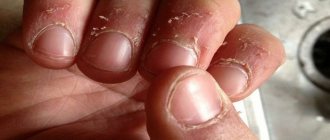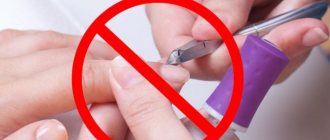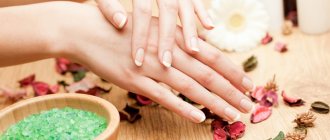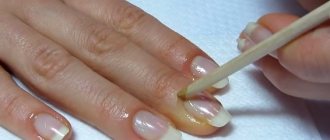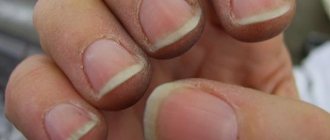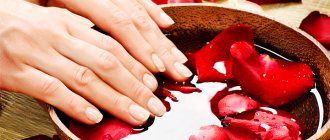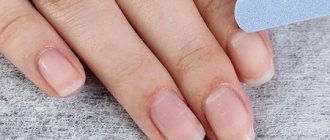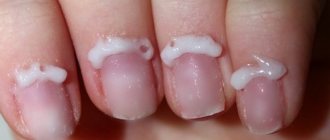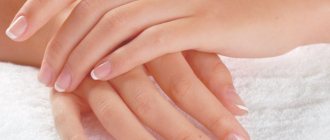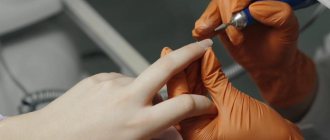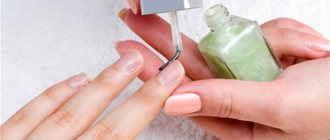The cuticle is the layer of skin at the base of the nails and its main purpose is to protect the nail. But the cuticles around your nails are often dry, sticky and unsightly. It can ruin the most beautiful manicure. The situation becomes especially difficult when cuticle removal becomes an addiction and wounds form on the fingers. In addition, cuticle damage can occur with frequent contact with detergents. It gets to the point that the girl stops showing her hands to the world, which she shamefully hides in her pockets. But all you could do was regularly soften the cuticle. How to care for the cuticle so that it does not become a problem?
What is cuticle?
The cuticle is a roll of skin that, over a period of time, grows near the nail plate. It is very important and performs a protective function, protecting nails from pathogenic bacteria that can cause various diseases. To keep your cuticle healthy, you need to take care of it. This part of the skin is very delicate and sensitive. When in contact with aggressive substances, the cuticle dries out and becomes chapped. Then our hands take on an unkempt appearance.
Currently, there are a variety of cuticle softeners. With their help, you can take good care of your hands at home.
European manicure
Unlike trim manicure, European technology is more modern and safe. To carry out the procedure, you will need to place on a paper napkin a pre-sterilized cuticle stylus, vitamin E, cosmetic gel for removing cuticles, cotton swabs, and a composition to slow down skin growth around the base of the plate.
- Disinfect your hands, file your nails, giving them the desired shape. Using a stylus, move the cuticle towards the base of the nail plate.
- Shake the bottle of cuticle remover, squeeze the product onto a cotton swab and evenly cover the dead skin. Do not touch healthy areas, otherwise they will also “melt”.
- Study the back of the tube; the manufacturer indicates the interval that must be maintained. For European and American brands it ranges from 10 to 15 minutes.
- After the expiration date, it is necessary to remove the softener along with the cuticle. For these purposes, use a dry cotton swab. Swipe it from the right and left sides of the nail, moving the skin towards the middle. After this, wipe your finger with a cosmetic swab, wiping away the mushy mixture that resulted from mixing the cuticle with the remover.
- In cases where the dead cells are not completely steamed, clean them with an orange stick and a cotton pad soaked in olive oil.
- When the procedure has come to an end, rinse your hands, wipe your fingers with a cotton towel, rub vitamin A into your nails and the skin around them. Wait for the composition to be absorbed, apply a growth-slowing composition to the cuticle.
how to get rid of hangnails at home
Care products
If you want to take care of your hands yourself without visiting a beauty salon, you can purchase any softener or prepare it yourself.
- Creams and gels are most often intended to soften the skin and further remove it.
- Oil emulsions and oils are used for regular softening. They have a positive effect not only on the skin, but also on the nail plate itself.
- Baths are also good for softening the cuticle.
- Hand and cuticle creams should be used as daily care. They contain substances that support skin health.
- To wash your hands, you need to purchase soap with caring substances (oils, herbs, minerals).
What is a cuticle and what is its function?
To understand what a cuticle is, look at your nails. At the very base, where the nail plate emerges from under the skin, it is covered with a thin translucent film that fits tightly to the surface. This film is the outer edge of the cuticle, consisting of dead cells. It must be removed during a hygienic or decorative manicure.
The function of the living part of the cuticle is that it is a kind of barrier that prevents dirt, bacteria and germs from penetrating into the base of the nail plates. It is recommended to remove dead skin because it gives the nails an unkempt appearance. In addition, under certain conditions, it may begin to fray. As a result, hangnails appear, which make the hands even more unkempt and cause pain and discomfort.
What is a remover?
Trimmed manicure has been gradually fading into the background lately. It has long been replaced by unedged manicure. Modern cuticle removers are very easy to use and do not harm the skin at all.
A remover is a gel, cream or liquid cosmetic product that allows you to quickly get rid of regrown skin. Thanks to this cosmetic product, you can quickly get your nails in order and prepare them for extensions. Removers contain substances that soften the skin at the base of the nail. The keratinized cuticle is removed using alkaline or acidic substances. Along with the skin, impurities that accumulate under the skin roll are also cleansed. Cuticle removers are recommended to be used instead of trimmed manicure, and also as a preparatory step before extensions.
The principle of action of such a substance is very simple. The product is applied to the skin around the nail, and after a few minutes the softened cuticle is removed using an orange stick. Next, oil is applied to the treated area. It is used to soften the blow after using the remover. This allows you to soothe inflamed skin and relieve irritation.
How to remove film without cutting
Removing cuticles without cutting is a method that is suitable only for those girls and women who have a very thin film at the base of their nails. In this case, after steaming the skin, it is enough to work with a pusher or an orange stick, pushing the excess skin towards the root of the nail plate. The pressure should not be too strong, otherwise the nails may become lumpy.
Having freed the nail plate from dead skin, you can apply varnish or other decorative coating without fear that it will quickly crack at the base of the nail.
Disadvantages of edged manicure
The classic cut manicure is a proven procedure for years that allows you to take care of the cuticle. Overgrown nail skin is physically removed using instruments. To do this, use cuticle tweezers or scissors. Recently, edged manicures have been used less and less. The reason for this is its multiple disadvantages:
- Sores and cuts. As you know, the skin in the area of the nail folds is incredibly delicate and thin. Even doing a manicure yourself, you can get injured, since it is always difficult to calculate where the regrown part ends and living tissue begins. It is even more difficult for masters in salons to find this border. Therefore, even experienced masters make mistakes.
- The procedure is not safe. Open wounds can always become a source of infection and purulent processes. It is very good if the salon employs executive masters who disinfect instruments after each procedure. Otherwise, the risk of contracting very serious diseases is high.
- Manicure is difficult for home use. It is difficult to trim the cuticle evenly and beautifully on your own.
Benefits of the remover
Trimming manicure is associated with many inconveniences. To avoid them, you can use a remover. However, like any cosmetic product, it has its advantages and disadvantages. The advantages of the product include:
- No mechanical damage. They are simply not possible because cuticle tweezers or scissors are not used. This means that the risk of infection is eliminated. The remover cannot cause cuts. After a salon procedure, it is almost impossible to contract any infection.
- Simplicity and ease of use. Even the most inexperienced person can do an unedged manicure. The remover eliminates the need to painstakingly cut out the skin for a long time. The whole procedure goes quite quickly. The substance is applied to the cuticle, and you just have to wait a little for it to take effect.
- With regular use of removers, the cuticle becomes more well-groomed and grows slower.
Disadvantages of removers
Removers have a number of disadvantages:
- They contain alkaline components. Even in minimal quantities they can be harmful. If the nail plate is infected with fungus, removers will only worsen the condition.
- Such preparations should not be used frequently as they lead to softening of the nails. They can take on an uneven shape if removers are used without measure. Experts say that they can be used no more than twice a month.
- The drug is applied strictly along the edge. If you miss and apply it a little further, there may be unpleasant consequences in the form of softening of the nail and damage to the skin fold.
As you can see, removers also have their drawbacks, although they are not comparable to the dangers of trimmed manicure. Increasingly, in salons, masters offer European (unedged manicure), which is simpler and gives good results.
Types of removers
How to remove cuticle at home? The easiest way is to use removers. Even an inexperienced person can cope with the procedure. If you want to purchase such a product for home use, then it is worth knowing what types there are.
- Acid. The name itself allows us to judge its composition. These removers are based on lactic, fruit and other acids. The product has a very fast effect. The skin softens in literally two to three minutes. Acid removers are used for home and salon use.
- Alkaline. The substance is characterized by a more severe effect. With its help, a manicure can be done in just a minute. When applied correctly, the product can practically not harm the skin and nail plate. Only professionals can work with it, which is why such removers are used in salons.
- Oil removers are very rarely found on sale. They do not contain solvents. The products simply make the cuticle more pliable and softer. After this, it can be removed without using tweezers or scissors. It is better to use a special manicure stick. Oil products make softening the cuticle a completely invisible process. Removers have a mild effect that does not cause allergies.
- Minerals have a non-aggressive composition. Oils are most often used. Their great advantage is that they are supplemented with all kinds of caring components. In fact, it turns out that the same product not only removes the cuticle, but also nourishes the skin and nails with a vitamin cocktail. Mineral removers do not have any serious disadvantages. Allergic reactions occur rarely, and only if a person is intolerant to some component.
So different: how to work correctly with different types of cuticle
The cuticle is a real “fine matter” of manicure art. It can be healthy or problematic, and for any type of cuticle it is very important to choose the right manicure. How to remove the cuticle correctly and not cause harm to the client?
Dry cuticle: how to remove and care
How to work with wet cuticle correctly
What to do if the cuticle is “creeping”
How to treat tight cuticles
How to cure injured cuticle
Dry cuticle: how to remove and care
Dry cuticles can be a real headache for its owner. A dry, unmoisturized cuticle protects the area around the nail less well, and hangnails are more likely to appear on it. And this creates a threat of inflammation and even fungal diseases. Needless to say, dry cuticles make your nails look simply untidy?
A nail technician should be careful when treating dry cuticles. A trimmed manicure is not suitable - when removing with scissors or a tweeter, there is a risk of damaging thin skin. Due to closely spaced capillaries, the cut cuticle may begin to “bleed,” which is not only painful, but also fraught with infection.
The best option for working with dry cuticles is a hardware manicure. With the help of a properly selected cutter, pterygium can be cleaned off without harming the sensitive cuticle. After all, with this method, the keratinized skin is not cut off, but carefully polished.
In the future, the dry cuticle should be treated with a special oil. Organic products based on sweet almond and jojoba oils and moisturizers are perfect. Additionally, it is imperative to remind the client to avoid contact with chemicals and hard water without gloves. It is precisely this aggressive environment that most often leads to dry nails and cuticles. However, it can also be due to problems in the body such as stress, malnutrition and even certain medications.
How to work with wet cuticle correctly
Wet cuticles may be associated with hand hyperhidrosis. It is highly elastic, so it should be removed with extreme caution. If handled roughly, the wet cuticle may tear!
A combined manicure is best for wet cuticles. Before removing such a cuticle, it must be dried. This will make it much easier to remove dead skin. After this, the cuticle is pushed back with a pusher, and the pterygium is cleaned with a cutter.
Cleaning with a cutter should be done in such a way as to lift the wet cuticle. This will make it much more convenient to cut it with manicure scissors. At the end of the treatment, the cuticle and side ridges are polished with a milling cutter with a soft corundum attachment.
What to do if the thinned cuticle “creeps”
Thin cuticles tend to grow on the nail plate and can crack over time. Not only does this make your nails look unpleasant, but there is a risk of inflammation and infection. Such a “creeping” cuticle requires especially careful care!
During a manicure session, the growing cuticle is lifted with a cutter, the pterygium is cleaned, and the side ridges are polished. The cuticle itself should be carefully cut with nail scissors or a tweeter along the growth line - this way it will grow correctly in the future.
The client can take care of growing cuticles at home. To do this, you need to move it away from time to time with an orange stick. Before doing this, it is better to soften the cuticle with special oil.
How to treat tight cuticles
If the cuticle is very dense, working with it can make the specialist sweat. Sometimes an unedged, European manicure is enough. However, not every master will be able to successfully push back the cuticle and leave the client with a result they like. Therefore, you can combine edged and European methods.
To remove thick cuticles, it is recommended to use special removers. The remover is kept from a few seconds to five minutes (depending on the product). During this time, it will thin the keratinized skin, and its roughest areas can be cut off. The remaining part of the cuticle is pushed back with an orange stick or pusher.
To soften rough cuticles, you can regularly lubricate them with peach cuticle oil.
How to cure injured cuticle
Not all clients are able to keep their hands in perfect condition. Due to injury, illness or common bad habits, the area around the nail can become damaged. Burrs, wounds and cracks may appear on the cuticle and side ridges. Therefore, the master needs to be as careful as possible!
Damaged cuticles are treated exclusively with trimmed manicure. The hardware method will not work - when grinding with a cutter, there is a risk of further injuring the cuticle. If there are open wounds, the periungual area must be treated with an antiseptic. Burrs and cuticles are cut off with nail scissors.
To help problematic cuticles heal faster, you can use natural cuticle oils. Products enriched with vitamins and intended for particularly sensitive skin are best suited. After a manicure session, it would not be superfluous to refer the client to a dermatologist. A medical professional will be able to conduct the necessary examination and prescribe treatment. After all, health is the key to beautiful and graceful hands!
Tools Overview
If you are thinking about how to remove cuticles at home, then you should purchase a remover. This tool will greatly facilitate and speed up the procedure. You will forever forget about cutting your cuticles. In order to purchase the right product in the store, we suggest that you familiarize yourself with the most popular ones.
Beauty Triumph remover pencil is a product of a domestic manufacturer. The cuticle softener looks like a felt-tip pen or marker. With its help, you can apply softening liquid with great precision. The revumer contains oils and vitamin E.
Professionals note that this is one of the best cuticle oils. The pencil is easy to use and has a convenient packaging. The pointed cap makes it easy to push back cuticles without any additional tools. The cost of the product ranges from 500-700 rubles.
Cuticle Away by CND
Cuticle gel contains alkali. And aloe extract has a calming effect, softening the effect of active components. The product is suitable for home and salon use.
The cost of the gel is 900 rubles. The drug has a fairly liquid consistency, making it easy to apply. It copes well even with neglected cuticles and at the same time has a gentle effect on the skin and nail plate.
How to protect your cuticle
Manicure is, in any case, a traumatic process for the cuticle, and the modern external environment is quite aggressive: chlorinated water, for example, is very harmful to the cuticle and the nail plate in general.
Steps to take to protect your cuticles and nails from damage and keep them healthy:
- Even if you prefer a home manicure, you should entrust your nails to the masters once every two months: a salon manicure is comprehensive care, it is high-quality and professional, it promotes nail growth and the correct formation of the cuticle.
- Avoid the formation of burrs; if they appear, carefully cut with scissors, do not tear off under any circumstances.
- Use only high-quality manicure cosmetics; your health and beauty are not something you can skimp on. Protecting the cuticle from varnish, especially cheap and low-quality ones, is especially important.
- When working with household chemicals, detergents and cleaners, as well as when washing and mopping floors, use protective gloves.
Cuticle protection is very important, don't neglect these simple tips and you won't have to worry about the health of your nails.
Manicure at home
Whatever composition the removers have, they are used in practice in almost the same way.
To get rid of cuticles at home you need:
- Take a bath before manicure in warm water. This procedure is only necessary for neglected hands.
- Use an orange stick to push the skin to the base of the nail.
- Gently apply the product to the cuticle. An orange stick will help you do this exactly.
- Remove cuticle.
- Rinse off any remaining product with water.
- Apply cosmetic oil or cream to nails and cuticles.
How to do edged and unedged manicure
If you still opt for a trimmed manicure, it is better to have it done in a professional salon. Although many can do it at home.
Recommendations for removing cuticles:
- Step 1. First, treat your hands and all used manicure tools with a disinfectant, remember: trimmed manicure is really dangerous and can cause infection.
- Step 2. Shape your nails: it is very important to do this before working with the cuticle, because a softened nail cannot be processed with a file, it will begin to flake and break.
- Step 3. Make a softening bath, immerse your fingers in it for 10-15 minutes, and then apply a special cuticle softener.
- Step 4. When the cuticle has become soft and ready for further procedure, carefully push it away with a pusher, being careful not to scratch the nail.
- Step 5. Cut the cuticle with scissors or special tweezers.
- Step 6. At the end, be sure to treat the nail and skin around it with some nourishing oil or regular fatty cream.
Hardware manicure
Currently, a new manicure method has emerged that is convenient for home use. It is usually called hardware. It has become widespread just recently. Many women take only the first steps in mastering it. Semi-professional and professional devices can be seen on sale in many household appliance stores. The contents of the sets may vary. However, the device has a cone-shaped cuticle cutter. Before starting work, the skin is slightly pushed back and degreased. And then they are treated with a special nozzle in two directions: down and up.
The cuticle cutter does the job perfectly. During operation, you only need to lightly press the device onto the skin so as not to injure it. The set also includes spherical and rectangular attachments for treating nails. The most advanced devices include a felt attachment for final polishing. Similar products are available in every beauty salon. But you can also purchase the simplest option for yourself, which runs on batteries.
Natural oils: the best options for skin and nails
The following types of natural oils are most often used to nourish and moisturize the skin around the nails:
- Apricot. The most useful base product, provides hydration and softening even to very rough and dry cuticles. Promotes regeneration, heals minor injuries.
- Almond. Saturated with fatty acids, quickly absorbed. Indispensable for softening dry skin and restoring split nails.
- Avocado. Rich in vitamin F and natural antioxidants. A very fatty and viscous product copes well with hangnails and returns softness and elasticity to the cuticle.
- Castor. Suitable for the treatment of local inflammation, quickly restores damaged skin. Very liquid, it is more convenient to apply with a brush or cotton swab.
- Grape seed. A popular product that is often used in beauty salons. Absorbs quickly and does not leave a sticky film. Rich in tocopherol, quickly restores damaged skin and helps strengthen nails.
- Coconut. An ideal product for caring for cuticles after a trim manicure. Rich in vitamins A and E, moisturizes and nourishes the skin, promotes nail growth.
- Peach. Contains rare vitamin B15, well restores skin and nails after trimmed manicure. Can be used as a prophylactic against fungal diseases.
If valuable natural products are not at hand, you can apply ordinary edible oils to the cuticle: flaxseed, sunflower, soybean or olive.
You can make effective blends with essential oils at home. The esters of sweet orange, lemon, geranium, and tea tree are especially useful for the cuticle. The recipe is simple: for 1 tbsp. l. add 5 drops of essential oil to the base product. The mixture is poured into a dark glass bottle and stored in a cool place.
The application of oil is accompanied by a mandatory massage.
Tools for working with cuticles
Not all women like to fight the cuticle. For many, rough skin becomes a real problem. Currently, there are a lot of products that soften the cuticle well. After their impact, all that remains is to carefully remove it. To work with leather, you should have the following tools in your home arsenal:
- Trimmer. The tool has a specific shape that looks like the letter V. It is a good alternative to cuticle nippers. The edges of the trimmer are highly sharpened, so it must be used with caution.
- The cuticle file looks like a honeycomb. It can be solid or mesh. The file is very convenient to use because it does not damage the nail plates.
- Pencil. The cuticle product resembles an applicator or brush. Inside the drug there is a nourishing oil. The pencil also has a cuticle file.
- Europumza is a product for removing dead skin, which is used if the gel does not cope with the task. The drug consists of a mixture of phosphorus and aluminum.
Home Remedies to Soften Cuticles
You can get rid of rough skin not only with ready-made cosmetics, but also with home remedies. Folk recipes are quite capable of helping modern women. The most effective remedies are oils. Apricot, castor, lavender, wheat and jojoba are ideal for home use.
There are several ways to soften the cuticle:
- Bath with oil and salt. The container is filled with warm water, after which a pinch of sea salt is dissolved and a few drops of oil are added. Fingers are dipped into the bath and steamed. Afterwards, the cuticle is pushed back and hand cream is applied.
- Oil massage. Hands are steamed in warm water and the skin is peeled back. After which any oil is applied to it and the periungual ridges are massaged.
